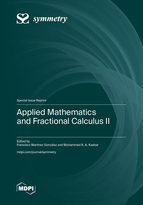Applied Mathematics and Fractional Calculus II
A special issue of Symmetry (ISSN 2073-8994). This special issue belongs to the section "Mathematics".
Deadline for manuscript submissions: closed (31 July 2023) | Viewed by 28565
Special Issue Editors
Interests: fractional calculus; real analysis; complex analysis; mathematical physics; numerical analysis; computational science; mathematical modeling; theoretical physics; signal processing
Special Issues, Collections and Topics in MDPI journals
Interests: mathematics; electrical engineering; computer engineering; antennas and wave propagation; modern electronics; data analysis; design project; sustainable development; new technology
Special Issues, Collections and Topics in MDPI journals
Special Issue Information
Dear Colleagues,
In the last three decades, fractional calculus has broken into the field of mathematical analysis, both at the theoretical level and at the level of its applications. In essence, the fractional calculus theory is a mathematical analysis tool applied to the study of integrals and derivatives of arbitrary order, which unifies and generalizes the classical notions of differentiation and integration. These fractional and derivative integrals, which until not many years ago had been used in purely mathematical contexts, have been revealed as instruments with great potential to model problems in various scientific fields, such as: fluid mechanics, viscoelasticity, physics, biology, chemistry, dynamical systems, signal processing or entropy theory. Since the differential and integral operators of fractional order are nonlinear operators, fractional calculus theory provides a tool for modeling physical processes, which in many cases is more useful than classical formulations. That is why the application of fractional calculus theory has become a focus of international academic research.
Dr. Francisco Martínez González
Dr. Mohammed K. A. Kaabar
Guest Editors
Manuscript Submission Information
Manuscripts should be submitted online at www.mdpi.com by registering and logging in to this website. Once you are registered, click here to go to the submission form. Manuscripts can be submitted until the deadline. All submissions that pass pre-check are peer-reviewed. Accepted papers will be published continuously in the journal (as soon as accepted) and will be listed together on the special issue website. Research articles, review articles as well as short communications are invited. For planned papers, a title and short abstract (about 100 words) can be sent to the Editorial Office for announcement on this website.
Submitted manuscripts should not have been published previously, nor be under consideration for publication elsewhere (except conference proceedings papers). All manuscripts are thoroughly refereed through a single-blind peer-review process. A guide for authors and other relevant information for submission of manuscripts is available on the Instructions for Authors page. Symmetry is an international peer-reviewed open access monthly journal published by MDPI.
Please visit the Instructions for Authors page before submitting a manuscript. The Article Processing Charge (APC) for publication in this open access journal is 2400 CHF (Swiss Francs). Submitted papers should be well formatted and use good English. Authors may use MDPI's English editing service prior to publication or during author revisions.
Keywords
- fractional calculus
- fractional derivative
- fractional integral
- multivariable fractional calculus
- fractional differential equations
- fractional partial derivative equations
- fractional physical equations
Benefits of Publishing in a Special Issue
- Ease of navigation: Grouping papers by topic helps scholars navigate broad scope journals more efficiently.
- Greater discoverability: Special Issues support the reach and impact of scientific research. Articles in Special Issues are more discoverable and cited more frequently.
- Expansion of research network: Special Issues facilitate connections among authors, fostering scientific collaborations.
- External promotion: Articles in Special Issues are often promoted through the journal's social media, increasing their visibility.
- e-Book format: Special Issues with more than 10 articles can be published as dedicated e-books, ensuring wide and rapid dissemination.
Further information on MDPI's Special Issue polices can be found here.
Related Special Issue
- Applied Mathematics and Fractional Calculus III in Symmetry (2 articles)







